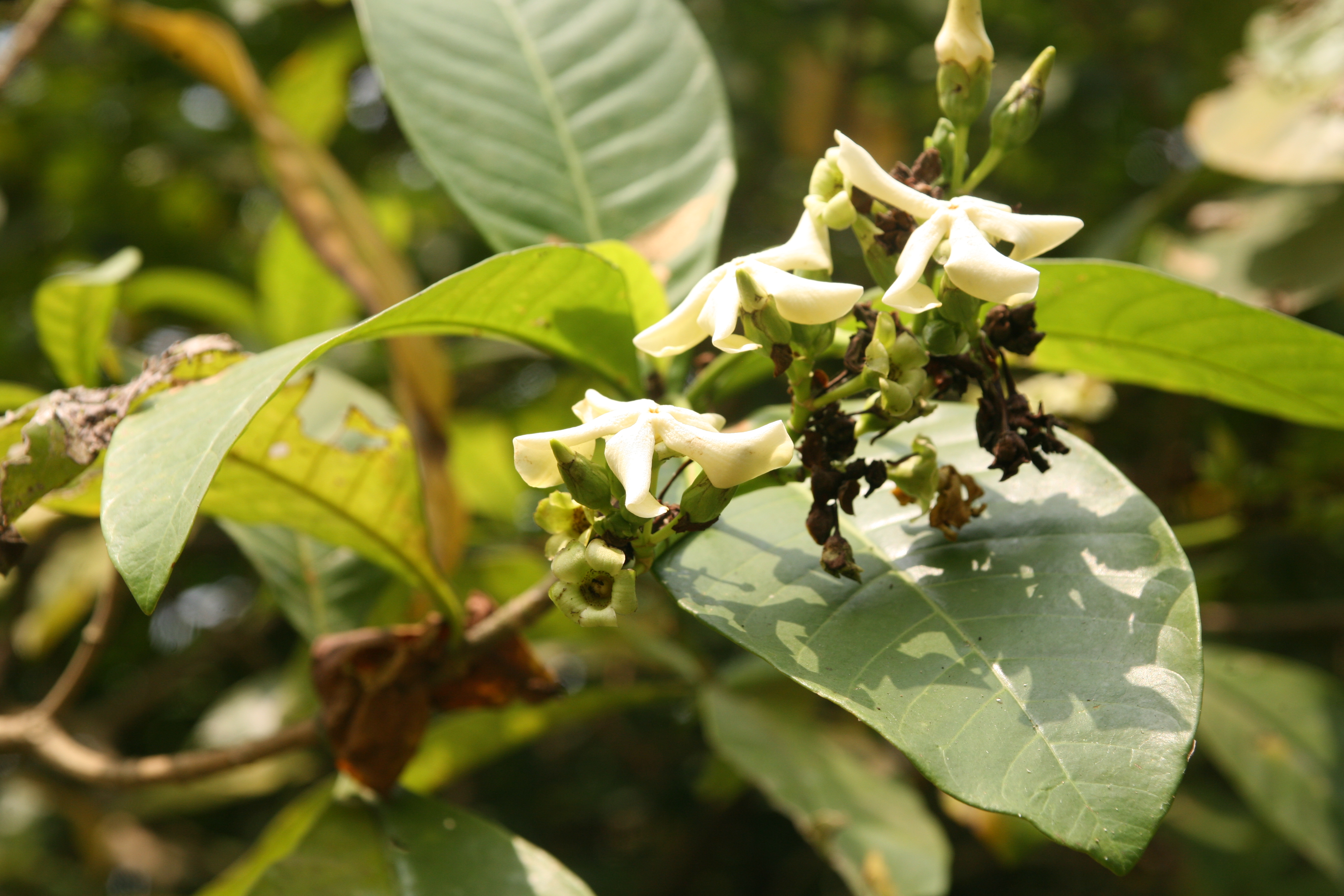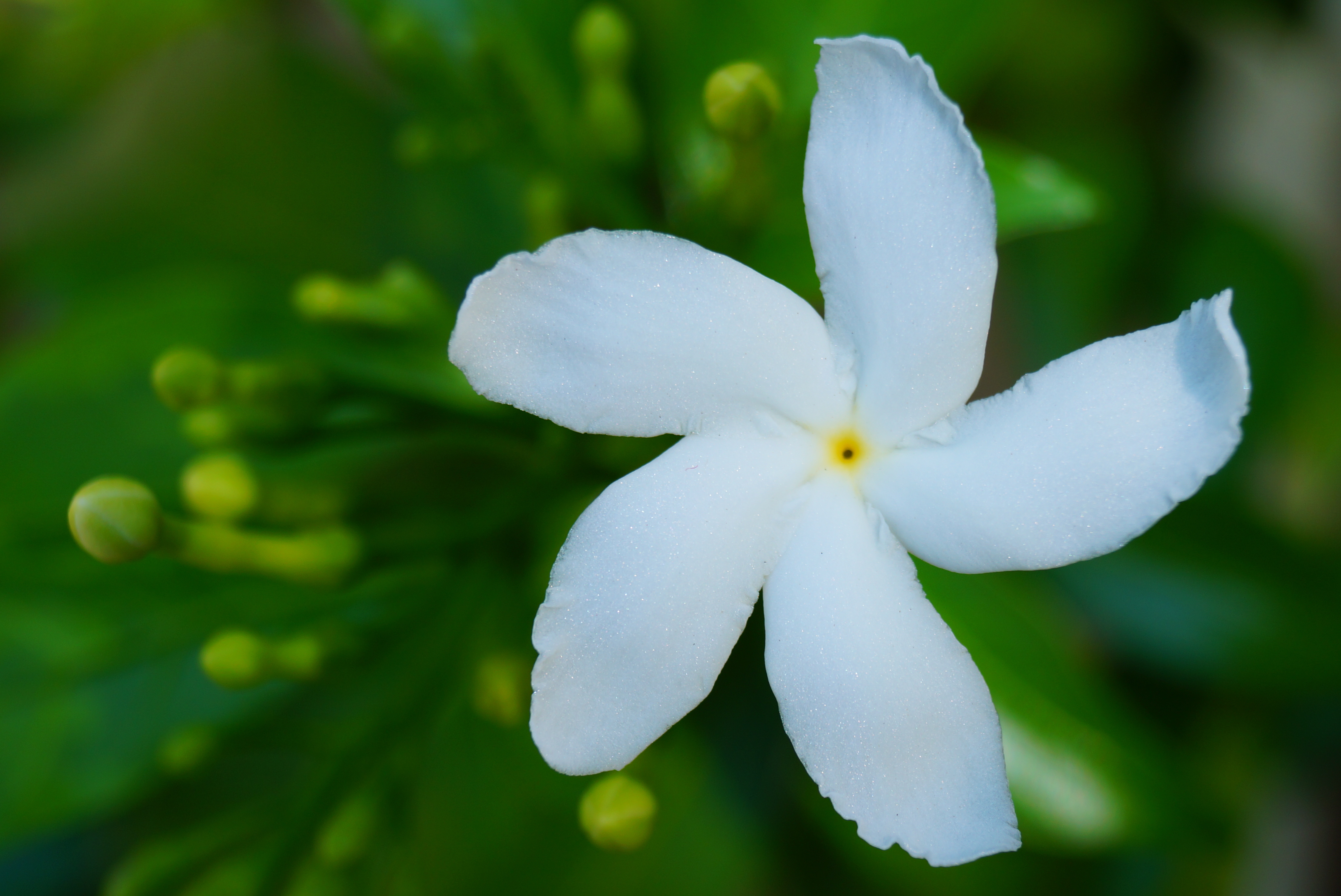|
Tabernaemontana Elegans
''Tabernaemontana elegans'', the toad tree, is a shrub or small tree in the family Apocynaceae. It is native to eastern Africa. Description ''Tabernaemontana elegans'' grows up to tall, with a trunk diameter of up to . Its fragrant flowers feature white, creamy or pale yellow corolla lobes. Fruit consists of 2 separate ovoid or ellipsoid pods, up to each. Distribution and habitat ''Tabernaemontana elegans'' grows in forests or bushland from sea level to altitude. The species is native to Somalia, Kenya, Tanzania, Mozambique, Zimbabwe, Eswatini and South Africa. Uses ''Tabernaemontana elegans'' has some local medicinal uses including the treatment of heart disease, cancer, tuberculosis and venereal diseases. The species is also used as an aphrodisiac. The Zulu name for this genus, ''iNomfi'', refers to the use of their sticky, milky latex as bird-lime. Chemistry Fourteen indole alkaloids have been isolated in the callus culture of ''Tabernaemontana elegans'' (isovoacangine ... [...More Info...] [...Related Items...] OR: [Wikipedia] [Google] [Baidu] |
Limpopo
Limpopo is the northernmost province of South Africa. It is named after the Limpopo River, which forms the province's western and northern borders. The capital and largest city in the province is Polokwane, while the provincial legislature is situated in Lebowakgomo. The province is made up of 3 former homelands of Lebowa, Gazankulu and Venda and the former parts of the Transvaal province. The Limpopo province was established as one of the new nine provinces after South Africa's first democratic election on the 27th of April 1994. The province's name was first "Northern Transvaal", later changed to "Northern Province" on the 28th of June 1995, together with two other provinces. The name was later changed again in 2002 to the Limpopo province. Limpopo is made up of 3 main ethnic groups namely; Pedi people, Tsonga and Venda people. Traditional leaders and chiefs still form a strong backbone of the province's political landscape. Established in terms of the Limpopo House of Tr ... [...More Info...] [...Related Items...] OR: [Wikipedia] [Google] [Baidu] |
Plants Described In 1894
Plants are predominantly photosynthetic eukaryotes of the kingdom Plantae. Historically, the plant kingdom encompassed all living things that were not animals, and included algae and fungi; however, all current definitions of Plantae exclude the fungi and some algae, as well as the prokaryotes (the archaea and bacteria). By one definition, plants form the clade Viridiplantae (Latin name for "green plants") which is sister of the Glaucophyta, and consists of the green algae and Embryophyta (land plants). The latter includes the flowering plants, conifers and other gymnosperms, ferns and their allies, hornworts, liverworts, and mosses. Most plants are multicellular organisms. Green plants obtain most of their energy from sunlight via photosynthesis by primary chloroplasts that are derived from endosymbiosis with cyanobacteria. Their chloroplasts contain chlorophylls a and b, which gives them their green color. Some plants are parasitic or mycotrophic and have lost the ability ... [...More Info...] [...Related Items...] OR: [Wikipedia] [Google] [Baidu] |
Tabernaemontana
''Tabernaemontana'' is a genus of flowering plants in the family Apocynaceae. It has a pan-tropical distribution, found in Asia, Africa, Australia, North America, South America, and a wide assortment of oceanic islands. These plants are evergreen shrubs and small trees growing to 1–15 m tall. The leaves are opposite, 3–25 cm long, with milky sap; hence it is one of the diverse plant genera commonly called "milkwood". The flowers are fragrant, white, 1–5 cm in diameter. The cultivar '' T. divaricata'' cv. 'Plena', with doubled-petaled flowers, is a popular houseplant. Some members of the genus ''Tabernaemontana'' are used as additives to some versions of the psychedelic drink ayahuasca; the genus is known to contain ibogaine (e.g. in bëcchëte, ''T. undulata''), conolidine (present in minor concentration in ''T. divaricata'') and voacangine ('' T. alba'', '' T. arborea'', '' T. africana''). Because of presence of coronaridine and voacangine in Mexican ''Tabernae ... [...More Info...] [...Related Items...] OR: [Wikipedia] [Google] [Baidu] |
Apparicine
Apparicine is a monoterpenoid indole alkaloid. It is named after Apparicio Duarte, a Brazilian botanist who studied the ''Aspidosperma'' species from which apparicine was first isolated. It was the first member of the vallesamine group of alkaloids to be isolated and have its structure established, which was first published in 1965. It has also been known by the synonyms gomezine, pericalline, and tabernoschizine. Biochemistry The alkaloid has been isolated from seven species of ''Aspidosperma''. It is the principal alkaloid found in the callus of ''Tabernaemontana elegans'', and has also been identified in other ''Tabernaemontana'' species, including '' T. africana'', '' T. divaricata'', '' T. orientalis'', and '' T. pachysiphon''. In studies of ''T. pachysiphon'', it was found that alkaloid content including that of apparicine was greatest in young leaves and leaves receiving greater shade, and varied with leaf age, plant age, and provenance. Research on '' Aspidosperma pyri ... [...More Info...] [...Related Items...] OR: [Wikipedia] [Google] [Baidu] |
Vobasine
Vobasine is a naturally occurring monoterpene indole alkaloid found in several species in the genus ''Tabernaemontana'' including ''Tabernaemontana divaricata''. History Vobasine was first reported by Renner in 1959 after its isolation from ''Voacanga africana''. The two structurally related compounds, dregamine and tabernaemontanine, where its alkene (=CHCH3) sidechain was reduced to ethyl groups in two configurations, had their relationship confirmed in the 1970s. Vobasine has been found in many plants of the dogbane (Apocynaceae) family including '' Tabernaemontana dichotoma''. Synthesis Biosynthesis As with other Indole alkaloids, the biosynthesis of vobasine starts from the amino acid tryptophan. This is converted into strictosidine before further elaboration. Chemical synthesis The synthesis of alkaloids with the same carbon skeleton as vobasine began in the 1960s and has continued, with some work providing enantiospecific approaches to closely-related compounds. Natur ... [...More Info...] [...Related Items...] OR: [Wikipedia] [Google] [Baidu] |
Tabernaemontanine
Tabernaemontanine is a naturally occurring monoterpene indole alkaloid found in several species in the genus ''Tabernaemontana'' including ''Tabernaemontana divaricata''. History Tabernaemontanine was first reported in 1939 but its structure was only fully confirmed in the 1970s as there was confusion in the original literature regarding the configuration of the ethyl group in the piperidine ring of this alkaloid and its isomer dregamine, so that their identities had been reversed. Both compounds were isolated from plants of the dogbane (Apocynaceae) family including '' Tabernaemontana coronaria''. They have structures that are reduced versions of vobasine. Biosynthesis As with other Indole alkaloids, the biosynthesis of tabernaemontanine starts from the amino acid tryptophan. This is converted into strictosidine before further elaboration. Natural occurrence Tabernaemontanine is found commonly in the genera ''Tabernaemontana'' and ''Kopsia'', including the species '' Ervatamia h ... [...More Info...] [...Related Items...] OR: [Wikipedia] [Google] [Baidu] |
Coronaridine
Coronaridine, also known as 18-carbomethoxyibogamine, is an alkaloid found in ''Tabernanthe iboga'' and related species, including ''Tabernaemontana divaricata'' for which (under the now obsolete synonym ''Ervatamia coronaria'') it was named. Like ibogaine, (''R'')-coronaridine and (''S'')-coronaridine can decrease intake of cocaine and morphine intake in animals and it may have muscle relaxant and hypotensive activity. Chemistry Congeners Coronaridine congers are important in drug discovery and development due to multiple actions on different targets. They have ability to inhibit Cav2.2 channel, modulate and inhibit subunits of nAChr selectively such as α9α10, α3β4 and potentiate GABAA activity. Pharmacology Coronaridine has been reported to bind to an assortment of molecular sites, including: μ-opioid (Ki = 2.0 μM), δ-opioid (Ki = 8.1 μM), and κ-opioid receptors (Ki = 4.3 μM), NMDA receptor (Ki = 6.24 μM) (as an antagonist), and nAChRs (as an antagonist). It h ... [...More Info...] [...Related Items...] OR: [Wikipedia] [Google] [Baidu] |
Otto Stapf (botanist)
Otto Stapf FRS (23 April 1857, in Perneck near Bad Ischl – 3 August 1933, in Innsbruck) was an Austrian born botanist and taxonomist, the son of Joseph Stapf, who worked in the Hallstatt salt-mines. He grew up in Hallstatt and later published about the archaeological plant remains from the Late Bronze- and Iron Age mines that had been uncovered by his father. Stapf studied botany in Vienna under Julius Wiesner, where he received his PhD with a dissertation on cristals and cristalloids in plants. 1882 he became assistant professor (''Assistent'') of Anton Kerner. In 1887 he was made '' Privatdozent'' (lecturer without a chair) in Vienna. He published the results of an expedition Jakob Eduard Polak, the personal physician of Nasr al-Din, the Shah of Persia, had conducted in 1882, and plants collected by Felix von Luschan in Lycia and Mesopotamia Mesopotamia ''Mesopotamíā''; ar, بِلَاد ٱلرَّافِدَيْن or ; syc, ܐܪܡ ܢܗܪ̈ܝܢ, or , ) is a ... [...More Info...] [...Related Items...] OR: [Wikipedia] [Google] [Baidu] |




